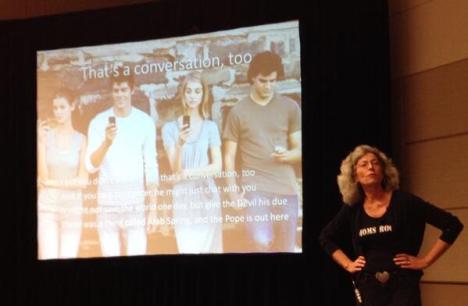More than 600 technical communicators met for the annual STC Summit in Phoenix, AZ, to demonstrate and expand the many ways in which they add value for users, clients, and employers. In a series of posts, I describe my personal Summit highlights and insights that resonated with me.
The journey to structured topics
I’ve framed my presentation “From Unstructured Documentation to Structured Topics” as a journey to a fjord precipice: Daunting, but nothing you cannot achieve with a some planning and a little bit of confidence.
In this “project walk-through mini-workshop”, I outlined how we can combine core tech comm proficiency, such as topic-based authoring, with content strategy and project management skills to master the migration to structured topics. The applied skills and the resulting content architecture can be a solid foundation for a full-blown future corporate content strategy that highlights technical communicators and their skills.
The engaged Q&A afterwards showed that the ideas resonated with the 80+ attendees. Many technical communicators are comfortable and well qualified to expand their topic-writing skills into information architectures and content modelling.
The trip to taxonomy
In her session “How to Create and Use a Functional Taxonomy“, Mollye Barrett told of a similar challenge: She was originally brought in to create the documentation for a highly customised implementation of financial software. When it became apparent that not just the software needed documentation, but also the workflows and processes which it was supposed to support, she wound up creating a taxonomy!
As she laid out her case study, Mollye showed how technical communicators’ core skills of task analysis and task-oriented documentation qualify them to create a taxonomy of business functions that maps a software’s functions to specific user tasks.
The project essentially consisted of explicating the company’s multi-faceted tacit knowledge and connecting all the pieces:
- Create a consistent terminology by defining the standard financial terms in use.
- Describe and classify the various functions of the software.
- Identify and describe the users tasks which need documentation.
Mollye studied disparate, unstructured legacy documents, examined the software, and worked with specialists from the business and IT sides. Her main driver was her persistence to eliminate ambiguity, her goal to define clear terms – or put more simply: to create order out of chaos.
Lightning strikes twice
A popular staple of the STC Summit is the two lightning talk rounds, moderated with understated wit by Rhyne Armstrong.
Liz Herman drove forward the multi-skilled tech comm theme with multiple costume changes in her talk “Perfecting the Hat Trick, Why My Hair’s Messy“. She demonstrated how tech comm’ers don the hats, caps, and helmets of sailors, fire fighters, cowboys, football players, the Irish, something I’ve forgotten and many more in just five minutes:
And Viqui Dill showed us how to use social media right in “Social Media is not the Devil“, her rousing karaoke performance to the tune of Charlie Daniels’ “The Devil Went Down to Georgia”:
Filed under: conferences, structured writing, topic-based authoring | Tagged: Liz Herman, Mollye Barrett, STC, STC Summit 2014, Viqui Dill |







Leave a comment